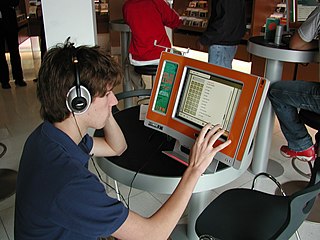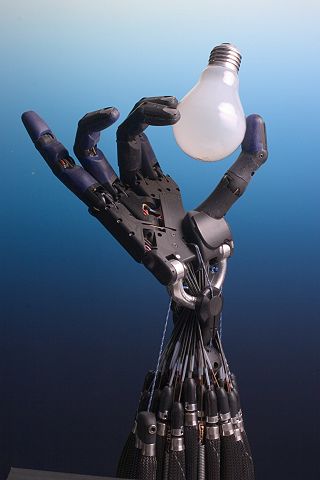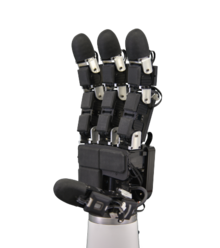
A sensor is a device that produces an output signal for the purpose of detecting a physical phenomenon.
Haptic technology is technology that can create an experience of touch by applying forces, vibrations, or motions to the user. These technologies can be used to create virtual objects in a computer simulation, to control virtual objects, and to enhance remote control of machines and devices (telerobotics). Haptic devices may incorporate tactile sensors that measure forces exerted by the user on the interface. The word haptic, from the Greek: ἁπτικός (haptikos), means "tactile, pertaining to the sense of touch". Simple haptic devices are common in the form of game controllers, joysticks, and steering wheels.
A mechanoreceptor, also called mechanoceptor, is a sensory receptor that responds to mechanical pressure or distortion. Mechanoreceptors are innervated by sensory neurons that convert mechanical pressure into electrical signals that, in animals, are sent to the central nervous system.

A touchscreen is a type of display that can detect touch input from a user. It consists of both an input device and an output device. The touch panel is typically layered on the top of the electronic visual display of a device. Touchscreens are commonly found in smartphones, tablets, laptops, and other electronic devices.

Simultaneous localization and mapping (SLAM) is the computational problem of constructing or updating a map of an unknown environment while simultaneously keeping track of an agent's location within it. While this initially appears to be a chicken or the egg problem, there are several algorithms known to solve it in, at least approximately, tractable time for certain environments. Popular approximate solution methods include the particle filter, extended Kalman filter, covariance intersection, and GraphSLAM. SLAM algorithms are based on concepts in computational geometry and computer vision, and are used in robot navigation, robotic mapping and odometry for virtual reality or augmented reality.

The Pacinian corpuscle, lamellar corpuscle or Vater-Pacini corpuscle is one of the four major types of mechanoreceptors for mechanical sensation) found in mammalian skin. This type of mechanoreceptor is found in both hairy, and hairless skin, viscera, joints, and attached to the periosteum of bone, primarily responsible for sensitivity to vibration. A few are also sensitive to quasi-static or low frequency pressure stimuli. Most of them respond only to sudden disturbances and are especially sensitive to vibration of a few hundreds hertz. The vibrational role may be used for detecting surface texture, such as rough and smooth. Most of the Pacinian corpuscles act as rapidly adapting mechanoreceptors. Groups of corpuscles respond to pressure changes, such as on grasping or releasing an object.
Sensory substitution is a change of the characteristics of one sensory modality into stimuli of another sensory modality.

A proximity sensor is a sensor able to detect the presence of nearby objects without any physical contact.

Ultrasonic transducers and ultrasonic sensors are devices that generate or sense ultrasound energy. They can be divided into three broad categories: transmitters, receivers and transceivers. Transmitters convert electrical signals into ultrasound, receivers convert ultrasound into electrical signals, and transceivers can both transmit and receive ultrasound.
Machine perception is the capability of a computer system to interpret data in a manner that is similar to the way humans use their senses to relate to the world around them. The basic method that the computers take in and respond to their environment is through the attached hardware. Until recently input was limited to a keyboard, or a mouse, but advances in technology, both in hardware and software, have allowed computers to take in sensory input in a way similar to humans.
Tactile discrimination is the ability to differentiate information through the sense of touch. The somatosensory system is the nervous system pathway that is responsible for this essential survival ability used in adaptation. There are various types of tactile discrimination. One of the most well known and most researched is two-point discrimination, the ability to differentiate between two different tactile stimuli which are relatively close together. Other types of discrimination like graphesthesia and spatial discrimination also exist but are not as extensively researched. Tactile discrimination is something that can be stronger or weaker in different people and two major conditions, chronic pain and blindness, can affect it greatly. Blindness increases tactile discrimination abilities which is extremely helpful for tasks like reading braille. In contrast, chronic pain conditions, like arthritis, decrease a person's tactile discrimination. One other major application of tactile discrimination is in new prosthetics and robotics which attempt to mimic the abilities of the human hand. In this case tactile sensors function similarly to mechanoreceptors in a human hand to differentiate tactile stimuli.
Haptic perception means literally the ability "to grasp something". Perception in this case is achieved through the active exploration of surfaces and objects by a moving subject, as opposed to passive contact by a static subject during tactile perception.
In electrical engineering, capacitive sensing is a technology, based on capacitive coupling, that can detect and measure anything that is conductive or has a dielectric constant different from air. Many types of sensors use capacitive sensing, including sensors to detect and measure proximity, pressure, position and displacement, force, humidity, fluid level, and acceleration. Human interface devices based on capacitive sensing, such as touchpads, can replace the computer mouse. Digital audio players, mobile phones, and tablet computers will sometimes use capacitive sensing touchscreens as input devices. Capacitive sensors can also replace mechanical buttons.

Robotics is the interdisciplinary study and practice of the design, construction, operation, and use of robots.

Touch is perceiving the environment using skin. Specialized receptors in the skin send signals to the brain indicating light and soft pressure, hot and cold, body position and pain. It is a subset of the sensory nervous system, which also includes the visual, auditory, olfactory, gustatory and vestibular senses.
Affective haptics is an area of research which focuses on the study and design of devices and systems that can elicit, enhance, or influence the emotional state of a human by means of sense of touch. The research field is originated with the Dzmitry Tsetserukou and Alena Neviarouskaya papers on affective haptics and real-time communication system with rich emotional and haptic channels. Driven by the motivation to enhance social interactivity and emotionally immersive experience of users of real-time messaging, virtual, augmented realities, the idea of reinforcing (intensifying) own feelings and reproducing (simulating) the emotions felt by the partner was proposed. Four basic haptic (tactile) channels governing our emotions can be distinguished:
- physiological changes
- physical stimulation
- social touch
- emotional haptic design.
Robotic sensing is a subarea of robotics science intended to provide sensing capabilities to robots. Robotic sensing provides robots with the ability to sense their environments and is typically used as feedback to enable robots to adjust their behavior based on sensed input. Robot sensing includes the ability to see, touch, hear and move and associated algorithms to process and make use of environmental feedback and sensory data. Robot sensing is important in applications such as vehicular automation, robotic prosthetics, and for industrial, medical, entertainment and educational robots.

Soft robotics is a subfield of robotics that concerns the design, control, and fabrication of robots composed of compliant materials, instead of rigid links. In contrast to rigid-bodied robots built from metals, ceramics and hard plastics, the compliance of soft robots can improve their safety when working in close contact with humans.
An Artificial Lateral Line (ALL) is a biomimetic lateral line system. A lateral line is a system of sensory organs in aquatic animals such as fish, that serves to detect movement, vibration, and pressure gradients in their environment. An artificial lateral line is an artificial biomimetic array of distinct mechanosensory transducers that, similarly, permits the formation of a spatial-temporal image of the sources in immediate vicinity based on hydrodynamic signatures; the purpose is to assist in obstacle avoidance and object tracking. The biomimetic lateral line system has the potential to improve navigation in underwater vehicles when vision is partially or fully compromised. Underwater navigation is challenging due to the rapid attenuation of radio frequency and Global Positioning System signals. In addition, ALL systems can overcome some of the drawbacks in traditional localization techniques like SONAR and optical imaging.
A Contact Region is a concept in robotics which describes the region between an object and a robot’s end effector. This is used in object manipulation planning, and with the addition of sensors built into the manipulation system, can be used to produce a surface map or contact model of the object being grasped.











